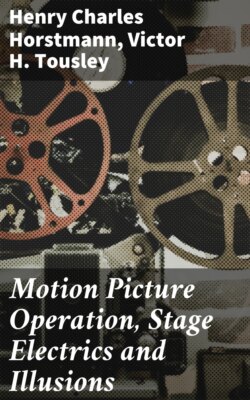Читать книгу Motion Picture Operation, Stage Electrics and Illusions - Henry Charles Horstmann - Страница 18
На сайте Литреса книга снята с продажи.
ОглавлениеFIGURE 7.
The electric current with which the operator has to deal may be either alternating or direct, and the kind is of great importance. The color of the light obtained from a direct-current arc is not only superior to that obtained from an alternating-current arc but is obtained at a much lower cost since, as we shall presently see, it is so much more efficient.
To project clear white light upon the screen is impossible, some color will always be in it. But by careful attention and by training himself to notice slight degrees of color, the operator can learn to render a light which will be clear enough to satisfy the majority of the spectators. In order to obtain this light, the source from whence it comes should be located exactly in the optical axis of the lens system; that is, a straight line drawn through the center of all of the lenses should pass also directly through the center of the arc as indicated in Figure 7. (For comprehensive treatise on lenses, see Chapter XII.)
FIGURE 8. FIGURE 9. FIGURE 10.
FIGURE 11. FIGURE 12. FIGURE 13.
Most of the light, we have already seen, is emitted from the crater of an arc of which there is but one in a direct-current arc and two in an alternating current arc. In order to obtain the most light with the least expenditure of current and heat in the lamp house, the crater must be formed in such a manner as to face the center of the condensers as nearly as possible. Since, however, there are always two electrodes and the current must pass from one to the other, the crater always tends to face the lower electrode if the upper one is positive. It is, therefore, impossible to get the full benefit of the light for the condenser; we must be satisfied with getting a part of it, and to do this such settings of electrodes as are shown in Figures 8 to 13 are used. About the relative merits of these various settings there is considerable dispute and the best advice that can be given to any new comer in the operating line is to make his own experiments and find out for himself. The fact that a certain point is much disputed, alone indicates that there is no exact knowledge available; for we very seldom have any differences of opinion about the things that we can prove.
In the operating line very much depends upon the judgment of the operator. Electrode setting like that of Figure 8 may be good for an operator who is extremely careful and has a reliable machine which requires a minimum of attention. But it can readily be seen that if the top electrode were fed a trifle too far forward, the crater would form underneath and the lenses would receive but a small part of the light. Each of the settings given has its peculiarities and it is best for any operator who has not done so, to try them all out and find which one best suits him and his conditions.
Figures 8 to 10 show the settings used with direct-current arcs; while those illustrated by Figures 11 to 13 are used with alternating-current arcs.
With alternating-current arcs the problem is even more difficult than with direct, for we have here two craters to deal with; and if we wish to use the light from both, we shall have to be very careful about it. If the electrodes are not set exactly right, we may get a double spot and poor illumination at the center of the screen. Perhaps most operators will soon give up the idea of using the light of both craters and will settle down to an electrode setting something like that shown in A, Figure 7. In this setting both electrodes are angled and the lower one is set a little ahead of the upper. This has a tendency to draw the crater of the upper electrode forward, thus improving the light on the condenser; but if this be carried too far, the lower electrode will obstruct the lower part of the lens. The lower electrode must always be set so that it allows all parts of the condenser to receive direct rays of light from the crater of the upper. The electrode must align perfectly in the vertical plane as shown in B, Figure 7, or the arc will move while burning.
In order to enable the operator to arrange his electrodes at any angle and to bring them into the center of the optical system, arc lamps are made up in various ways as illustrated in Figures 14 to 19. The simpler types are used only in stage lighting lamps where the centering is not so important. The more elaborate lamps are provided for motion picture arc lamps and allow of all necessary adjustments which are: feed electrodes; move lamps forward or back; up or down; sideways and angle electrodes.
Where direct current is used, the upper electrode must be fed approximately twice as fast as the lower; but with alternating current, they both feed at practically the same rate.
FIGURE 14.
Figure 14 shows a form of McIntosh stereopticon lamp.
FIGURE 15.
Figure 15 is a Kliegl lamp for open arc lamps.
FIGURE 16.
Figure 16 is an Edison lamp used for motion picture work.
FIGURE 17.
Figure 17 is a Kliegl lamp used for focusing purposes.
FIGURE 18.
Figure 18 shows the Powers lamp.
FIGURE 19.
Figure 19 shows one of the Motiograph Company lamps.
